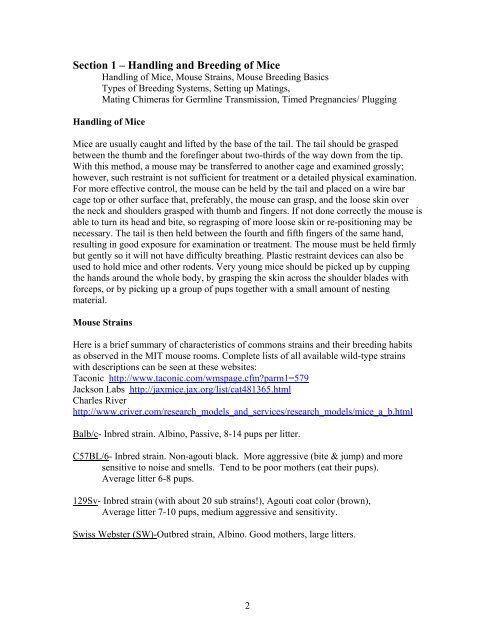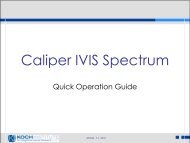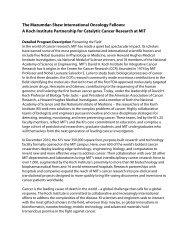Aurora's Guide to Mouse Colony Management
Aurora's Guide to Mouse Colony Management
Aurora's Guide to Mouse Colony Management
Create successful ePaper yourself
Turn your PDF publications into a flip-book with our unique Google optimized e-Paper software.
Section 1 – Handling and Breeding of Mice<br />
Handling of Mice, <strong>Mouse</strong> Strains, <strong>Mouse</strong> Breeding Basics<br />
Types of Breeding Systems, Setting up Matings,<br />
Mating Chimeras for Germline Transmission, Timed Pregnancies/ Plugging<br />
Handling of Mice<br />
Mice are usually caught and lifted by the base of the tail. The tail should be grasped<br />
between the thumb and the forefinger about two-thirds of the way down from the tip.<br />
With this method, a mouse may be transferred <strong>to</strong> another cage and examined grossly;<br />
however, such restraint is not sufficient for treatment or a detailed physical examination.<br />
For more effective control, the mouse can be held by the tail and placed on a wire bar<br />
cage <strong>to</strong>p or other surface that, preferably, the mouse can grasp, and the loose skin over<br />
the neck and shoulders grasped with thumb and fingers. If not done correctly the mouse is<br />
able <strong>to</strong> turn its head and bite, so regrasping of more loose skin or re-positioning may be<br />
necessary. The tail is then held between the fourth and fifth fingers of the same hand,<br />
resulting in good exposure for examination or treatment. The mouse must be held firmly<br />
but gently so it will not have difficulty breathing. Plastic restraint devices can also be<br />
used <strong>to</strong> hold mice and other rodents. Very young mice should be picked up by cupping<br />
the hands around the whole body, by grasping the skin across the shoulder blades with<br />
forceps, or by picking up a group of pups <strong>to</strong>gether with a small amount of nesting<br />
material.<br />
<strong>Mouse</strong> Strains<br />
Here is a brief summary of characteristics of commons strains and their breeding habits<br />
as observed in the MIT mouse rooms. Complete lists of all available wild-type strains<br />
with descriptions can be seen at these websites:<br />
Taconic http://www.taconic.com/wmspage.cfm?parm1=579<br />
Jackson Labs http://jaxmice.jax.org/list/cat481365.html<br />
Charles River<br />
http://www.criver.com/research_models_and_services/research_models/mice_a_b.html<br />
Balb/c- Inbred strain. Albino, Passive, 8-14 pups per litter.<br />
C57BL/6- Inbred strain. Non-agouti black. More aggressive (bite & jump) and more<br />
sensitive <strong>to</strong> noise and smells. Tend <strong>to</strong> be poor mothers (eat their pups).<br />
Average litter 6-8 pups.<br />
129Sv- Inbred strain (with about 20 sub strains!), Agouti coat color (brown),<br />
Average litter 7-10 pups, medium aggressive and sensitivity.<br />
Swiss Webster (SW)-Outbred strain, Albino. Good mothers, large litters.<br />
2





